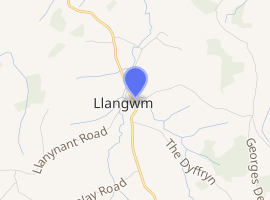St Jerome's Church, Llangwm
The Church of St Jerome stands in the settlement of Llangwm Uchaf, (upper) Llangwm, in a remote part of Monmouthshire, Wales. Originally constructed in the twelfth century, in an Early English style, it was heavily restored in the nineteenth century. The church has a "large and unusual"[1] tower, an "outstanding"[1] late-Medieval rood screen and Victorian interior fittings of "exceptional quality".[1] After being declared redundant by the Church in Wales, the church is now administered by the Friends of Friendless Churches. It was designated a Grade I listed building on 19 August 1955.
| Church of St Jerome, Llangwm Uchaf, Llangwm | |
|---|---|
 | |

| |
| 51.696°N 2.830°W | |
| Location | Llangwm, Monmouthshire |
| Country | Wales |
| History | |
| Status | Redundant |
| Dedication | St Jerome |
| Architecture | |
| Heritage designation | Grade I |
| Designated | 19 August 1955 |
| Architect(s) | John Pollard Seddon - Restoration |
History and architecture
The church is constructed of Old Red Sandstone and is first mentioned in 1128.[2] It has a tower, without buttresses, a large nave and chancel and a porch.[1] Largely ruined by the 19th century, it was comprehensively restored in 1863-9 by John Pollard Seddon.[2] Repairs were carried out by The Friends of Friendless Churches in 2013-4.[3]
Interior
Newman writes that "the glory of the interior is the rood screen and loft",[2] which British Listed Buildings Online describes as "one of the finest in Britain" and of "exceptional richness and complexity."[1] It has been heavily, but sympathetically, restored by Seddon. Of the same, latter, date, the lectern, the font, the choir stalls, the pews and the tiling throughout the church, the whole representative of Seddon "at his most imaginative."[2]
Behind the screen can be seen "green men with verdure sprouting from their mouths."[4] The sculptures are believed to have inspired Julia, Lady Raglan to write about the "Green Man" motif in her seminal 1939 article "The Green Man in Church Architecture" in The Folklore Journal.[5]
Notes
- Good Stuff IT Services (1963-08-19). "Church of St Jerome, Llangwm Uchaf". British Listed Buildings. Retrieved 2012-02-12.
- The Buildings of Wales:Gwent/Monmouthshire, page 316-7
- Good Stuff IT Services. "Llangwm Uchaf". Friends of Friendless Churches. Archived from the original on 2014-05-19. Retrieved 2012-02-12.
- Wales - Churches, Houses, Castles, page 187
- ": Theories and Interpretations". The Enigma of the Green Man. Retrieved 24 August 2016.
References
- Jenkins, Simon (2008). Wales - Churches, Houses, Castles. Allen Lane; London;
- Newman, John (2002). Gwent/Monmouthshire. New Haven; London: Yale University Press. ISBN 978-0-300-09630-9.